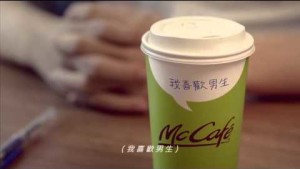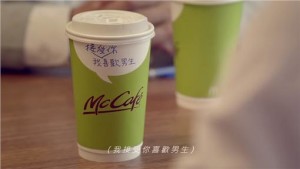Recently, a McDonald’s advertisement launched in Taiwan, my home country, caught my attention. The purpose of the commercial was to market McDonald’s “chat cup” for McCafe, a cup that would allow one to warmly greet others with words and great coffee.
The commercial was a story about coming out of the closet. A son wrote “I like boys” on the cup and passed it to his father. Nervous about the father’s reaction, the son sat there and waited anxiously. The father took the cup, added a few words to the cup and passed it back to the son. “I ‘accepted that you’ like boys” was the new sentence appeared on the cup. The advertisement soon went viral after it was launched. While most people found the commercial warm and touching, there were still people angry about the advertisement because they believed that the ad was encouraging “incorrect gender knowledge” and claimed that they would resist buying McDonald’s. “I won’t even go use the bathrooms in McDonald’s anymore”, one of the resistant claimed.
 The cup with the words: “I like boys”.
The cup with the words: “I like boys”.
 “I ‘accepted that’ you like boys”.
“I ‘accepted that’ you like boys”.
Video for McDonald’s chat cup:
https://www.youtube.com/watch?v=4CfgO56C0I8
In addition to this particular commercial, I found that there have been more and more homosexual issues being inserted in advertisements in recent years. For example, Burger King’s “Proud Whopper” and its campaigns were significantly successful with more than more than 7M views across all social platforms. Australian bank ANZ’s GayTMs were hugely popular and thousands of people took them to social media to spread the message. Airbnb’s #HostWithPride film broke a leg and caused a great response by showing the challenges queer couples may face while planning trips or traveling. The trend made me wonder the motivation behind these advertisements and the consequences of these launching these advertisements.
https://www.youtube.com/watch?v=NNah94XacS4
https://www.youtube.com/watch?v=SWDW114cji8
First of all, I’ve noticed that LGBT advertisements have a higher chance to go viral due to the debate between gender equality promoters and conservatives who are against gay marriage or other gender issues. Such as the Chat cup advertisement mentioned earlier, the protests of conservatives actually created more news coverage of the product. Regardless of the practical sales of the advertised product or service, I consider adding LGBT elements in advertisements a good way to raise attention.
Second, there has been more and more attention focused on LGBT rights and studies have shown that people’s opinion toward LGBT issues actually influence how they make purchase decisions. The phenomenon is especially true among young millennials. According to Snyder (2015), 47.4% of consumers under 24 years old claimed that they were more likely to support a brand after seeing an equality-themed ad. Of them, more than 54% further stated that they would choose an equality-focused brand over its competitor.
Last but not least, LGBT ads could directly attract LGBT buyers. I recalled a social psychology approach learned in a persuasion communication course. According to the theory, similarity increases liking, and liking increases the success rate of persuasion. The LGBT elements shown in the advertisements may present similarities between the characters in the ads and actual LGBT population, and further increase the liking of LGBT population toward the ads and the advertised product. According to an analysis conducted by Witeck Communications, the combined buying power of the U.S. LGBT adult for 2014 was estimated at $884 billion (Witeck Communications, 2015). It will be beneficial to increase the liking among such a great buying power.
To sum up, I think it is a great strategy to include LGBT elements or themes in ads because they can increase publicity and the liking among gender equality promoters and the LGBT population.
Reference:
https://www.thinkwithgoogle.com/articles/lgbt-advertising-brands-taking-stance-on-issues.html
http://www.fastcocreate.com/3026968/a-bank-transforms-its-atms-into-gaytms-in-honor-of-gay-pride
Snyder, B. (2015). LGBT advertising: How brands are taking a stance on issues.
Witeck Communications. (2015). America’s LGBT 2014 buying power estimated at $884 billion.
Retrieved from: http://www.witeck.com/pressreleases/americas-lgbt-2014-buying-power-estimated-at-884-billion/

10 Responses to Add some “Pride” in your ad: LGBT Advertising